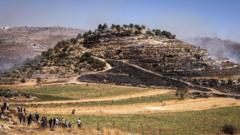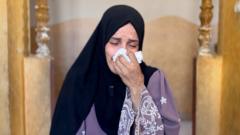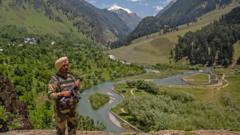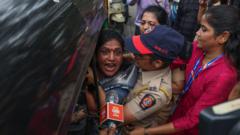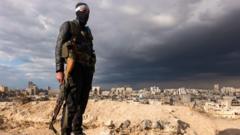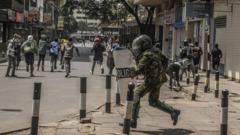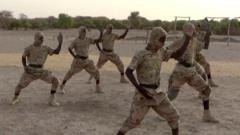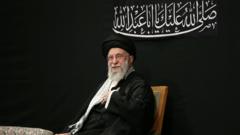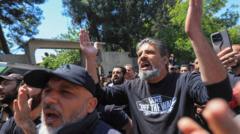The ongoing violence in Syria has resulted in massive casualties, particularly within the Alawite community, as eyewitness accounts paint a horrific picture of looting and mass killings following the ousting of Bashar al-Assad.**
Rampant Violence Erupts in Syria Amid Alawite Community Killings**
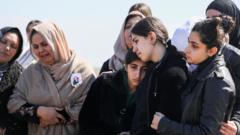
Rampant Violence Erupts in Syria Amid Alawite Community Killings**
Civilians in Syria are grappling with terror as revenge killings escalate against Alawite families, sparking a plea for unity amidst chaos.**
In the latest escalation of violence in Syria, local residents have recounted gut-wrenching scenes of terror as retaliation against Alawite families has surged in Latakia and Tartus, regions historically loyal to former president Bashar al-Assad. Eyewitnesses describe streets littered with bodies and rampant looting, prompting fear and panic among the residents who have begun to flee their homes.
Witness accounts from Hai Al Kusour, an Alawite-dominated area within Banias, reveal a horrifying reality. Individuals reported seeing men, women, and children shot dead in their homes, leaving families in utter despair. One resident, Ayman Fares, shared his close call during the violence after having been imprisoned for a video denouncing Assad. Now released, he recounted how he narrowly escaped death while witnessing brutal killings occurring just outside his window.
The situation has garnered attention from international observers, with reports indicating more than 740 civilians dead amidst clashes involving both the Syrian security forces and factions loyal to Assad. The current interim leadership has urged for order and unity, yet widespread fears linger as numerous armed groups, including former security forces, threaten stability.
Despite the chaos, some community members are stepping up to protect their Alawite neighbors. One local, Ali, noted the solidarity shown by Sunni families, who have taken in Alawite refugees. The stark contrast of community support amidst violence illustrates the complexities of sectarian divisions exacerbated by years of conflict.
As violence proliferates, Ghiath Dallah, a former general in the Assad regime, has announced a new faction aimed at overcoming the current government. This has prompted fears of further sectarian violence, particularly as many Alawites express a rejection of these hardline elements.
The broader sentiment among many survivors of the clashes calls for accountability and justice against the aggressors while also denouncing the interim government led by Ahmad al-Sharaa for exacerbating tensions within a vulnerable society. With the majority of Syria's population living under the poverty line, this unrest presents a ripe opportunity for radical factions to gain power.
In a complex web of taking sides and seeking revenge, the interim president's call for calm struggles against the existing demands for justice and safety. With factions controlling various regions, the road to a secure and democratic Syria appears fraught with challenges. Observers stress that the absence of foreign fighters and a constitution protecting every Syrian citizen's rights will be essential for restoring peace. The current landscape illuminated by violence serves as a critical reminder of the ongoing struggle toward establishing a stable future for Syria.
Witness accounts from Hai Al Kusour, an Alawite-dominated area within Banias, reveal a horrifying reality. Individuals reported seeing men, women, and children shot dead in their homes, leaving families in utter despair. One resident, Ayman Fares, shared his close call during the violence after having been imprisoned for a video denouncing Assad. Now released, he recounted how he narrowly escaped death while witnessing brutal killings occurring just outside his window.
The situation has garnered attention from international observers, with reports indicating more than 740 civilians dead amidst clashes involving both the Syrian security forces and factions loyal to Assad. The current interim leadership has urged for order and unity, yet widespread fears linger as numerous armed groups, including former security forces, threaten stability.
Despite the chaos, some community members are stepping up to protect their Alawite neighbors. One local, Ali, noted the solidarity shown by Sunni families, who have taken in Alawite refugees. The stark contrast of community support amidst violence illustrates the complexities of sectarian divisions exacerbated by years of conflict.
As violence proliferates, Ghiath Dallah, a former general in the Assad regime, has announced a new faction aimed at overcoming the current government. This has prompted fears of further sectarian violence, particularly as many Alawites express a rejection of these hardline elements.
The broader sentiment among many survivors of the clashes calls for accountability and justice against the aggressors while also denouncing the interim government led by Ahmad al-Sharaa for exacerbating tensions within a vulnerable society. With the majority of Syria's population living under the poverty line, this unrest presents a ripe opportunity for radical factions to gain power.
In a complex web of taking sides and seeking revenge, the interim president's call for calm struggles against the existing demands for justice and safety. With factions controlling various regions, the road to a secure and democratic Syria appears fraught with challenges. Observers stress that the absence of foreign fighters and a constitution protecting every Syrian citizen's rights will be essential for restoring peace. The current landscape illuminated by violence serves as a critical reminder of the ongoing struggle toward establishing a stable future for Syria.



